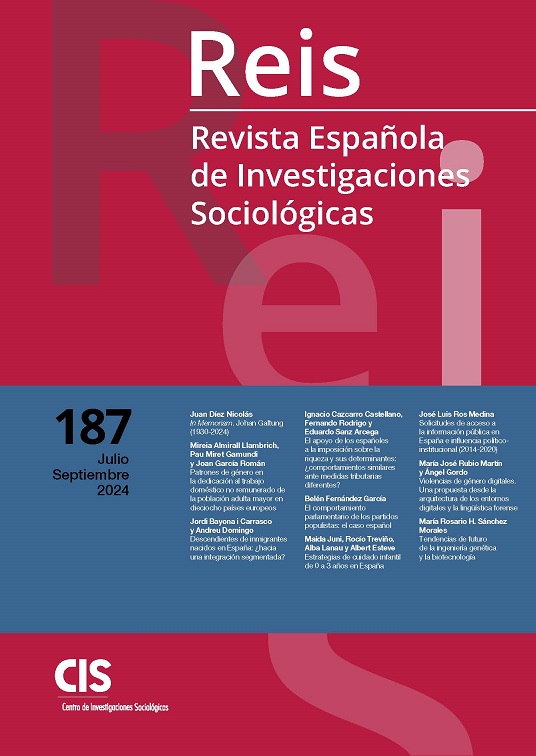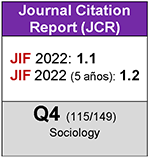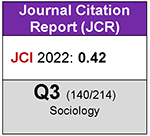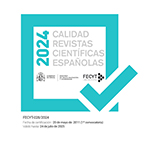Digital Gender Violence. A Proposal from the Architecture of Digital Environments and Forensic Linguistics
DOI:
https://doi.org/10.5477/cis/reis.187.129-146Keywords:
Affordances, Algorithms, Gamer Culture, Digital Environments, Valorant, Gender-Based ViolenceAbstract
Despite its increasing presence, gender-based digital violence has yet to be suitably addressed by current analyses, regulations or
protocols. This article tentatively proposes the development of a new interdisciplinary sociological research approach to bridge the
gap between forensic linguistics and the study of digital environment designs. We argue that the structure of these digital environments predisposes them to certain gender-based violent interactions, which are already ingrained in our cultures, and which manifest through linguistic resources and usage. To illustrate this connection, we present a brief case study on the Valorant video game. Despite the preliminary nature of this work, we believe that it may contribute to the development of tools for the detection and analysis of genderbased violence over the Internet.
Downloads
References
Ananías, Cecilia A. y Sánchez, Karen D. (2019). «Violencia en Internet contra Feministas y otras Activistas Chilenas». Revista de Estudios Feministas, 27(3): 1-13. doi: 10.1590/1806-9584-2019v27n358797 DOI: https://doi.org/10.1590/1806-9584-2019v27n358797
Anti-Defamation League -ADL- (2022). Hate is no Game: Harassment and Positive Social Experiences in Online Games 2021. Disponible en: https://www.adl.org/hateisnogame, acceso 18 de agosto de 2023.
Antony, Ria; Chang, Victoria; Huy Ha-Hoaang, My-Thuan, Penaloza, Julio; Valdez, Joe y Gursay, Ayse (2023). Toxic By Design: Exploring the Relationship of
Game Affordances and Negative Behavior. I Conference 2023. University of Illinois at Urbana-Champaingn. Disponible en: https://hdl.handle.net/2142/117380, acceso 18 de agosto de 2023.
Areces, Sara (2023). Análisis en clave de género de las interacciones en chat de los y las jugadoras de Valorant. Tesis de Máster. Universidad de Oviedo. Disponible en: https://digibuo.uniovi.es/dspace/handle/10651/64095, acceso 21 de abril 2023.
Asociación Internacional de Lingüística Forense (International Association for Forensic and Legal Linguistics) (s.f.). Disponible en https://iafll.org/, acceso 17 de junio 2023, acceso 25 de agosto de 2023.
Banaji, Shakuntala y Bhat, Rammath (2021). Social Media and Hate. London: Routledge. DOI: https://doi.org/10.4324/9781003083078
Benedetti, Novella y Queralt, Sheila (2023). «A Literature Review of the Role of Forensic Linguistics in Gender-based Violent Crimes in Italy: Supporting Legal Professionals and Providing Scientific Evidence». Revista de Llengua i Dret, Journal of Language and Law, 79: 140-157. DOI: https://doi.org/10.58992/rld.i79.2023.3857
Benevieri, Iacopo (2022). Cosa indossavi? Le Parole nei Processi Penali per Violenza di Genere. Roma: Tab edizioni.
Bishop, Jonathan (2014). «U R Bias Love: Using ‘bleasure’ and ‘motif’ as Forensic Linguistic means to Annotate Twitter and Newsblog Comments for the Purpose of Multimedia Forensics». En: The 11th International Conference on Web Based Communities and Social Media. Disponible en: http://worldcomp-proceedings.com/proc/p2014/ SAM9715.pdf, acceso 10 de abril de 2023.
Bloomfield, Brian P.; Latham, Yvonne y Vurdubakis, Theo (2010). «Bodies, Technologies and Action Possibilities when is an Affordance?». Sociology, 44 (3): 415-433. doi: 10.1177/0038038510362469 DOI: https://doi.org/10.1177/0038038510362469
Bonet-Martí, Jordi (2021). «Los antifeminismos como contramovimiento: una revisión bibliográfica de las principales perspectivas teóricas y de los debates actuales». Teknokultura. Revista de Cultura Digital y Movimientos Sociales, 18(1): 61-71. doi: 10.5209/tekn.71303 DOI: https://doi.org/10.5209/tekn.71303
Citron, Danielle K. (2014). Hate Crimes in Cyberspace. Cambridge: Harvard University Press. DOI: https://doi.org/10.4159/harvard.9780674735613
Comisión Europea (2022). Propuesta de Directiva del Parlamento Europeo y del Consejo sobre la Lucha contra la Violencia contra las Mujeres y la Violencia Doméstica. Disponible en: https://eur-lex.europa.eu/legal-content/ES/TXT/PDF/?uri=CELEX:52022PC0105& from=EN, acceso 13 de abril de 2023.
Conley, John M. y O’Barr, William M. (2005). Just Words: Law, Language, Power. Chicago: University Chicago Press.
Costa, Elisabetta (2018). «Affordances-in-practice: an Ethnographic Critique of Social Media Logic and Context Collapse». New Media & Society, 20(10): 3641-3656. DOI: https://doi.org/10.1177/1461444818756290
Costall, Alan y Still, Arthur (1989). «Gibson’s Theory of Direct Perception and the Problem of Cultural Relativism». Journal for the Theory of Social Behavior, 19: 433-441. DOI: https://doi.org/10.1111/j.1468-5914.1989.tb00159.x
Cotterill, Janet (2003). The Language of Sexual Crime. New York: Palgrave Macmillan.
Coulthard, Malcolm (2004). «Author Identification, Idiolect and Linguistic Uniqueness». Applied Linguistics, 25(4): 431-447. DOI: https://doi.org/10.1093/applin/25.4.431
Crespo, Mario (2016). «Analysis of Parameters on Author Attribution of Spanish Electronic Short Texts». Research in Corpus Linguistics, 4: 25-32. DOI: https://doi.org/10.32714/ricl.04.03
Crosas, Inés y Medina-Bravo, Pilar (2019). «Ciberviolencia en la Red. Nuevas formas de retórica disciplinaria en contra del feminismo». Pappers, 104(1): 47-73. DOI: https://doi.org/10.5565/rev/papers.2390
Dhrodia, Azmina (2018). #ToxicTwitter: Violence against Women Online. Amnistía Internacional. Disponible en: https://www.amnesty.org/en/wp-content/uploads/2021/05/ACT3080702018ENGLISH.pdf, acceso 1 de abril de 2023.
Díaz-Fernández, Silvia y García-Mingo, Elisa (2022). «The Bar of Forocoches as a Masculine Online Place: Affordances, Masculinist Digital Practices and Trolling». New Media & Society, 0(0). doi: 10.1177/14614448221135631 DOI: https://doi.org/10.1177/14614448221135631
Dragiewicz, Molly; Burgess, Jean; Matamoros-Fernández, Ariadna; Salter, Michael; Suzor, Nicolas P.; Woodlock, Delanie y Harris, Bridget (2018). «Technology Facilitated Coercive Control: Domestic Violence and the Competing Roles of Digital Media Platforms». Feminist Media Studies, 18(4): 609-625. DOI: https://doi.org/10.1080/14680777.2018.1447341
Duportail, Judith (2019). El algoritmo del amor. Un viaje a las entrañas de Tinder. Barcelona: Editorial Contra.
Echevarria, Samantha G. (2021). Dating App Facilitated Sexual Violence: The Prevalence and Mental Health Effects. University of Central Florida. [Tesis doctoral]. Disponible en: https://stars.library.ucf.edu/honorstheses/926/, acceso 13 de abril de 2023.
EIGE (European Institute for Gender Equality) (2017). La ciberviolencia contra mujeres y niñas. Disponible en: https://eige.europa.eu/gender-based-violence/what-is-gender-based-violence, acceso 23 de abril de 2023.
EIGE (European Institute for Gender Equality) (2022). Combating Cyber Violence against Women and Girls. Disponible en: https://eige.europa.eu/gender-based-violence/cyber-violence-against-women, acceso 21 de agosto de 2023.
Éticas (2022). The External Audit of the VioGén System. Association Eticas Research and Innovation. Disponible en: https://eticasfoundation.org/wp-content/uploads/ 2022/ 04/ ETICAS-_-Auditori%CC%81a-Externa-del-sistema-VioGe%CC%81n-20220308.docx.pdf, acceso 12 de marzo de 2023.
Eubanks, Virginia (2018). Automating Inequality: How High-tech Tools Profile, Police, and Punish the Poor. New York: St. Martin's Press.
European Parliament (2020). Legislative Observatory. 2020/0361 (COD). Digital Services Act. Disponible en:
https://www.europarl.europa.eu/news/es/press-room/20220114IPR21017/una-ley-para-regular-las-plataformas-digitales-y-hacer-de-la-red-un-lugar-seguro, acceso 13 de abril de 2023.
European Women’s Lobby (2017). #HerNetHerRights. Mapping the State of Online Violence against Women and Girls in Europe. Disponible en: https://www.womenlobby.org/IMG/pdf/hernetherrights_resource_pack_2017_web_version.pdf, acceso 20 de mayo de 2023.
Garayzábal, Elena; Queralt, Sheila y Reigosa, Mercedes (2019). Fundamentos de la Lingüística Forense. Madrid: Síntesis.
Gibson, James J. (1966). The Senses Considered as Perceptual Systems. Boston: Houghton Mifflin.
Gijn-Grosvenor, Evianne van y Lamb, Michael (2016). «Between Online Sexual Groomers Approaching Boys and Girls». Journal of Child Sexual Abuse, 25(5): 577-596. DOI: https://doi.org/10.1080/10538712.2016.1189473
Ging, Debbie (2020). «Alphas, Betas, and Incels: Theorizing the Masculinities of the Manosphere». Men and Masculinities, 22(4): 638-657. doi: 10.1177/1097184X17706401 DOI: https://doi.org/10.1177/1097184X17706401
Ging, Debbie y Siapera, Eugenia (2018). «Special Issue on Online Misogyny». Feminist Media Studies, 18(4): 515-524. DOI: https://doi.org/10.1080/14680777.2018.1447345
Ging, Debbie y Siapera, Eugenia (eds.) (2019). Gender Hate Online: Understanding the New Anti-feminism. Cham: Springer International Publishing. DOI: https://doi.org/10.1007/978-3-319-96226-9
Gómez, Alejandro y Calderón, Daniel (2023). Videojuegos y jóvenes. Lugares, experiencias y tensiones. Madrid: Fundación Fad Juventud.
González-Prieto, Ángel; Brú, Antonio; Nuño, Juan C. y González-Álvarez, José L. (2021). «Hybrid Machine Learning for Risk Assessment in Gender-Based Crime». Computers and Society. arXiv:2106.11847 [cs.CY]. doi: 10.48550/arXiv.2106.11847
GREVIO (2021). Recommendation No. 1 on the Digital Dimension of Violence against Women. Adopted on 20 October 2021. Disponible en: https://rm.coe.int/grevio-rec-no-on-digital-violence-against-women/1680a49147, acceso 1 de octubre de 2023.
Gunawan, Fergyanto; Ashianti, Livia y Sekishita, Nobumasa (2018). «A Simple Classifier for Detecting Online Child Grooming Conversation». TELKOMNIKA, 16(3): 1239-1248. DOI: https://doi.org/10.12928/telkomnika.v16i3.6745
Gupta, Aditi; Kumaraguru, Ponnurangam y Sureka, Ashish (2012). «Characterizing Pedophile Conversations on the Internet using Online Grooming. arXiv:1208.4324». Disponible en: http://precog.iiitd.edu.in/, acceso 1 de marzo de 2022.
Heft, Harry (1989). «Affordances and the Body: An Intentional Analysis of Gibson's Ecological Approach to Visual Perception». Journal for the Theory of Social Behaviour, 19(1): 1-30. doi: 10.1111/j.1468-5914.1989.tb00133.x DOI: https://doi.org/10.1111/j.1468-5914.1989.tb00133.x
Hilvert-Bruce, Zorah y Neil, James T. (2020). «I'm Just Trolling: The Role of Normative Beliefs in Aggressive Behaviour in Online Gaming». Computers in Human Behavior, 102: 303-311. doi: 10.1016/j.chb.2019.09.003 DOI: https://doi.org/10.1016/j.chb.2019.09.003
Hybridas y Komons (2020). Las violencias machistas en línea hacia activistas. Datos para entender el fenómeno. Calala, Fondo de Mujeres. Disponible en: https://calala.org/wp-content/uploads/2020/06/violencias-online-hacia-activistas-calala-2020.pdf, acceso 1 de marzo de 2021.
Instituto de las Mujeres (2022). Mujeres jóvenes y acoso en las redes sociales. Madrid: Ministerio de Igualdad.
Jane, Emma (2017). Misogyny Online: A Short (and Brutish) History. London: SAGE Publications Ltd. doi: 10.4135/9781473916029 DOI: https://doi.org/10.4135/9781473916029
Jurasz, Olga y Barker, Kim (2021). «Sexual Violence in the Digital Age: A Criminal Law Conundrum?». German Law Journal, 22(5): 784-799. doi: 10.1017/glj.2021.39 DOI: https://doi.org/10.1017/glj.2021.39
Kowert, Rachel (2020). «Dark Participation Games». Frontiers in Psychology, 11: 1-8. doi: 10.3389/fpsyg.2020.598947 DOI: https://doi.org/10.3389/fpsyg.2020.598947
Kramarae, Cheris (1988). Technology and Women's Voices: Keeping in Touch. London: Routledge & Kegan Paul. doi: 10.4324/9780203221938 DOI: https://doi.org/10.4324/9780203221938
Krendel, Alexandra (2020). «The Men and Women, Guys and Girls of the ‘Manosphere’: A Corpus-Assisted Discourse Approach». Discourse & Society, 31(6): 1-24. doi: 10.1177/0957926520939690 DOI: https://doi.org/10.1177/0957926520939690
Lorenzo-Dus, Nuria; Garcés-Conejos, Pilar y Bou-Franch, Patricia (2011). «On-line Polylogues and Impoliteness: The Case of Postings Sent in Response to the Obama Reggaeton YouTube Video». Journal of Pragmatics, 43: 2578-2593. doi: 10.1016/j.pragma.2011.03.005 DOI: https://doi.org/10.1016/j.pragma.2011.03.005
Méndez, Carmen y Linares, Esther (2022). Claves Lingüísticas para Ligar en tiempos de Tinder. En: M. Galindo y C. Méndez (eds.). La lingüística del amor: de la pasión a la palabra. Editorial Pie de página.
Ministerio de Igualdad (2020). Macroencuesta de Violencia contra la Mujer 2019. Disponible en: https://violenciagenero.igualdad.gob.es/violenciaEnCifras/ macroencuesta2015/Macroencuesta2019/home.htm, acceso 2 de febrero de 2023.
Ministerio del Interior (2019). Guía de Procedimiento VPR5.0 y VPER4.1. Protocolo de Valoración Policial del Riesgo y Gestión de la Seguridad de las Víctimas de Violencia de Género. Disponible en: https://violenciadegenerotic.files.wordpress.com/2019/05/ instruccion-4-2019.pdf, acceso 20 de febrero de 2023.
Ministerio de Justicia (2021). Unidades de Valoración Forense Interal (UVFI). Disponible en: https://www.mjusticia.gob.es/es/institucional/organismos/medicina-legal-ciencias/ unidades-de-valoracion-forense-integral, acceso 2 de marzo de 2023.
Naciones Unidas (2018). Informe de la Relatora Especial sobre la Violencia contra la Mujer, sus Causas y Consecuencias acerca de la Violencia En Línea contra las Mujeres y las Niñas desde la perspectiva de los Derechos Humanos. Disponible en: https://www.acnur.org /fileadmin/ Documentos/BDL/2016/10562.pdf, acceso 18 de agosto de 2023.
Nagle, Angela (2017). Kill all Normies. Online Culture Wars from 4chan and Tumblr to Trump and the Alt-Right. Washington: Zero books.
Noble, Safiya (2018). Algorithms of Oppression: How Search Engines Reinforce Racism. New York: New York University Press. DOI: https://doi.org/10.2307/j.ctt1pwt9w5
Norman, Donald A. (1988). The Psychology of Everyday Things. Basic books.
Parchoma, Gale (2014). «The Contested Ontology of Affordances: Implications for Researching Technological Affordances for Collaborative Knowledge Production». Computers in Human Behavior, 37: 360-368. DOI: https://doi.org/10.1016/j.chb.2012.05.028
Puente-Bienvenido, Héctor; Fernández-Ruiz, Marta y Ruiz-Torres, David (2022). «Interaction Affordances, Emergence and Sociality in Mobile Augmented Reality Video Games». Hipertext.net. Revista Académica sobre Documentación Digital y Comunicación Interactiva, 25: 123-126.
Queralt, Sheila (2022). Estafas amorosas. El Donjuán seduce, convence y manipula. Barcelona: Larousse.
Queralt, Sheila y Cicres, Jordi (2023). «Do Boys and Girls Write the Same? Analysis of Ngrams of Morphological Categories». Culture and Education, 35(1): 33-63. DOI: https://doi.org/10.1080/11356405.2022.2121130
Ribeiro Carreira, Rosângela A. (2021). «WhatsApp e o Contexto Discursivo como Prova de Violência». Language and Law/Linguagem e Direito, 8(2): 70-85. DOI: https://doi.org/10.21747/21833745/lanlaw8_2a4
Richardson-Self, Louise (2021). Hate Speech against Women Online: Concepts and Countermeasures. Lanham: Rowman & Littlefield. DOI: https://doi.org/10.5771/9781538147801
Rodríguez-Rodríguez, Ignacio; Rodríguez, José V.; Pardo-Quiles, Domingo J.; Heras-González, Purificación y Chatzigiannakis, Ioannis (2020). «Modeling and Forecasting Gender-based Violence through Machine Learning Techniques». Applied Sciences, 10(22): 8244. Disponible en: https://www.mdpi.com/2076-3417/10/22/8244/htm, acceso 15 de febrero de 2023. DOI: https://doi.org/10.3390/app10228244
Schwartz, Becca y Neff, Gina (2019) «The Gendered Affordances of Craigslist ‘New-in-Town Girls Wanted». New Media & Society, 21(11-12): 2404-2421. DOI: https://doi.org/10.1177/1461444819849897
Shepherd, Tamara; Harvey, Alison; Jordan, Tim; Srauy, Sam y Miltner, Kate (2015). «Histories of Hating». Social Media + Society, 1(2): 347-364. doi: 10.1177%2F2056305115603997 DOI: https://doi.org/10.1177/2056305115603997
Sun, Yinan y Suthers, Dan (2021). «Cultural Affordances and Social Media». En: Proceedings of the 54th Hawai International Conference on System Sciences. Disponible en: https://scholarspace.manoa.hawaii.edu/handle/10125/70982, acceso 3 de marzo de 2023. DOI: https://doi.org/10.24251/HICSS.2021.368
Sun, Yinan y Suthers, Dan (2022). «Examining Cultural and Technological Change: A Study of Cultural Affordances on WeChat». En: Proceedings of the 55th Hawai International Conference on System Sciences. Disponible en: https://scholarspace.manoa.hawaii.edu/items/b8bcb6d1-5a63-46cb-867b-ad5a84f40d84, acceso 20 de febrero de 2023.
Susanti, Allycia (2022). «GG’s and NT’s: Gaming Language in the Chat Feature of FPS Game Valorant». Diksi, 30(2): 109-116. doi: 10.21831/diksi.v30i2.52660 DOI: https://doi.org/10.21831/diksi.v30i2.52660
Valdivia, Ana; Hyde-Vaamonde, Cari y García-Marcos, Julián (2022). Judging the Algorithm: A Case Study on the Risk Assessment Tool for Gender-Based Violence implemented in the Basque Country. arXiv preprint arXiv:2203.03723. doi: 10.48550/arXiv.2203.03723
Varela, Francisco J.; Thompson, Eva y Rosch, Elenor (1991). The Embodied Mind: Cognitive Science and Human Experience. The MIT Press. DOI: https://doi.org/10.7551/mitpress/6730.001.0001
Vickery, Jacqueline y Everbach, Tracy (eds.) (2018). Mediating Misogyny: Gender, Technology and Harassment. London: Palgrave Macmillan. DOI: https://doi.org/10.1007/978-3-319-72917-6
Villar-Aguilés, Alicia y Pecourt, Juan (2021). «Antifeminismo y troleo de género en Twitter. Estudio de la subcultura trol a través de #STOPfeminazis». Teknokultura: Revista de Cultural Digital y Movimientos Sociales, 18 (1): 33-44. DOI: https://doi.org/10.5209/tekn.70225
Zambrano-Guerrero, Christian y Rodríguez-Pabón, Diana (2021). «Design Thinking como herramienta para prevenir la violencia basada en género en estudiantes universitarios». Revista Guillermo de Ockham 19(2): 293-306. doi: 10.21500/22563202.5316 DOI: https://doi.org/10.21500/22563202.5316
Zempi, Irene y Smith, Jo (2021). Misogyny as Hate Crime. London: Routledge. DOI: https://doi.org/10.4324/9781003023722
Zhang, Wei y Pérez-Tornero, José-Manuel (2022). «Theorizing Platformization from the Perspective of the Connection between mobile Journalism and Political Participation». Communication & Society, 35(3): 173-190. DOI: https://doi.org/10.15581/003.35.3.173-190
Zhou, Pei; Shi, Weijia; Zhao, Jieyu; Huang, Kuan-Hao; Chen, Muhao; Cotterell, Ryan y Chang, Kai-Wei (2019). «Examining Gender Bias in Languages with Grammatical Gender». En: Proceedings of the 2019 Conference on Empirical Methods in Natural Language Processing and the 9th International Joint Conference on Natural Language Processing (EMNLP-IJCNLP). China: Association for Computational Linguistics. Hong Kong. doi: 10.48550/arXiv.1909.02224 DOI: https://doi.org/10.18653/v1/D19-1531
Downloads
Published
How to Cite
Issue
Section
License
Copyright (c) 2024 Revista Española de Investigaciones Sociológicas

This work is licensed under a Creative Commons Attribution-ShareAlike 4.0 International License.
Permite Compartir — copiar y redistribuir el material en cualquier medio o formato, Adaptar — remezclar, transformar y construir a partir del material para cualquier propósito, incluso comercialmente.








